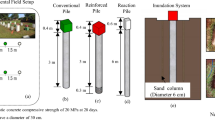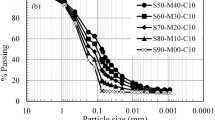Abstract
Soil collapse is a critical factor contributing to various pathologies in civil construction, necessitating the use of suction-controlled techniques, often unavailable in smaller cities in developing countries. This study investigated the collapsible behavior of clayey sand from Tuneiras do Oeste, Paraná, Brazil, using conventional one-dimensional tests with varied initial moisture contents and pre-soaking stresses. Tests maintained constant specimen moisture, soaked samples at pre-defined stress values (S tests), and observed collapse behavior under gradual wetting (GIM tests). Supplementary mercury intrusion porosimetry (MIP) analyses determined the collapse’s influence on pore size distribution. Collapse indexes were computed, and the Pereira and Fredlund (J Geotech Geoenviron Eng 126:907–916, 2000) model was applied to predict collapsible behavior for GIM tests data, showing strong agreement with experimental results (R2 > 0.98). Additionally, two prediction models developed from different test data also exhibited a high degree of correlation (R2 = 0.97 and 0.95 for S and GIM tests, respectively). It was observed that pre-soaking moisture, i.e., the pre-soaking matric suction, played a crucial role in wetting-induced soil collapse, while pre-soaking stress had a secondary effect. The infiltration rate during soaking impacted the observed collapse, with higher rates resulting in greater collapse magnitudes. Regarding soil structure, collapse led to significant alterations only in the macropores, causing a notable reduction in their diameters. Ultimately, the experimental protocol developed in this study yielded valid results for modeling collapsible soils, even in the absence of sophisticated suction-controlled equipment.









Similar content being viewed by others
Data availability
The data used to support the study is all included in the article.
References
Al-Obaidi QA, Schanz T (2022) Deformation of unsaturated collapsible soils under suction control. J Mech Behav Mater 31:623–630. https://doi.org/10.1515/jmbm-2022-0067
Alassal MA, Hassan AM, Elmamlouk HH (2023) Collapse potential prediction and characteristics of unsaturated sandy soils. Geotech Geol Eng 41:2759–2774. https://doi.org/10.1007/s10706-023-02425-5
American Society for Testing and Materials (2017) D2487–17e1: Standard practice for classification of soils for engineering purposes (Unified Soil Classification System). ASTM International. West Conshohocken, PA, USA, p. 10. https://doi.org/10.1520/D2487-17E01
American Society for Testing and Materials (2018) D4404: Standard test method for determination of pore volume and pore volume distribution of soil and rock by mercury intrusion porosimetry. ASTM International. West Conshohocken, PA, USA, p. 8. https://doi.org/10.1520/D4404-18
American Society for Testing and Materials (2020) D2435/D2435M-11: Standard test methods for one-dimensional consolidation properties of soils using incremental loading. ASTM International. West Conshohocken, PA, USA, p. 14. https://doi.org/10.1520/D2435_D2435M-11R20
American Society for Testing and Materials (2021) D4546: Standard test methods for one-dimensional swell or collapse of soils. ASTM International. West Conshohocken, PA, USA, p. 10. https://doi.org/10.1520/D4546-21
Associação Brasileira De Normas Técnicas (2016a) NBR 6458: Gravel grains retained on the 4.8 mm mesh sieve - determination of the bulk specific gravity, of the apparent specific gravity and of water absorption. ABNT. Rio de Janeiro, RJ, Brazil. (in Portuguese)
Associação Brasileira De Normas Técnicas (2016b) NBR 6459: Soil - liquid limit determination. ABNT. Rio de Janeiro, RJ, Brazil. (in Portuguese)
Associação Brasileira De Normas Técnicas (2016c) NBR 7180: Soil - Plasticity limit determination. ABNT. Rio de Janeiro, RJ, Brazil. (in Portuguese)
Associação Brasileira De Normas Técnicas (2016d) NBR 7181: Soil - Grain size analysis. ABNT. Rio de Janeiro, RJ, Brazil. (in Portuguese)
Baecher G, Christian J (2003) Reliability and statistics in geotechnical engineering. John Wiley&Sons Ltd., Chichester, England
Basma AA, Tuncer ER (1992) Evaluation and control of collapsible soils. J Geotech Eng 118(10):1491–1504. https://doi.org/10.1061/(ASCE)0733-9410(1992)118:10(1491)
Benatti JCB, Miguel MG, Rodrigues RA, Vilar OM (2011) Collapsibility study for tropical soil profile using oedometric tests with controlled suction. In: Proceedings of 5th International Conference on Unsaturated Soils. Barcelona, Spain, pp 193–198
Benatti JCB, Miguel MG (2013) A proposal of structural models for colluvial and lateritic soil profile from southwestern Brazil on the basis of their collapsible behavior. Eng Geol 153:1–11. https://doi.org/10.1016/j.enggeo.2012.11.003
Borges JJS, Torres MS, Veríssimo KJS, Freitas MLAA, Ferreira SEM (2016) Study of the flood effect on volume change, point resistance and modulus of elasticity of a collapsible soil in Pernambuco’s semi-arid. Matéria 21(4):996–1011. https://doi.org/10.1590/S1517-707620160004.0092. (in Portuguese)
Branco LP, Gomes AT, Cardoso AS, Pereira CS (2014) Natural variability of shear strength in a granite residual soil from Porto. Geotech Geol Eng 32:911–922. https://doi.org/10.1007/s10706-014-9768-1
Das AP, Thyagarj T (2016) Collapse behavior of compacted red soil. Int J Geotech Eng 12(1):20–27. https://doi.org/10.1080/19386362.2016.1243506
Duncan J (2000) Factors of safety and reliability in geotechnical engineering. J Geotech Geoenviron Eng 126(4):307–316. https://doi.org/10.1061/(ASCE)1090-0241(2000)126:4(307)
Ercoli L, Zimbardo M, Nocilla N, Nocilla A, Ponzoni E (2015) Evaluation of cliff recession in the Valle dei Templi in Agrigento (Sicily). Eng Geol 192:129–138. https://doi.org/10.1016/j.enggeo.2015.04.008
Ferreira SRM, Fucale SP (2014) Evaluation of the collapsibility of soils in the semiarid region of Pernambuco, Brazil. J Civ Eng Archit 8(10):1285–1292. https://doi.org/10.17265/1934-7359/2014.10.010
Ferreira SEM (1995) Collapse and expansion of natural unsaturated soils due to wetting. Thesis, Federal University of Rio de Janeiro. Rio de Janeiro, RJ, Brazil. (in Portuguese)
Fredlund DG, Xing A, Huang S (1994) Predicting the permeability function for unsaturated soils using the soil-water characteristic curve. Can Geotech J 31(4):533–546. https://doi.org/10.1139/t94-062
Ge M, Pineda JA, Sheng D, Burton GJ, Li N (2019) Collapse behaviour of compacted loess: role of the stress level on soil microstructure. Jpn Geotech Soc Spec Publ 7(2):209–214. https://doi.org/10.3208/jgssp.v07.032
Giomi I, Francisca FM (2022) Numerical modeling of the oedometrical behavior of collapsible loess. Geotech Geol Eng 40:2501–2512. https://doi.org/10.1007/s10706-021-02042-0
Gitirana GFN Jr, Fredlund DG (2004) Soil-water characteristic curve equation with independent properties. J Geotech Geoenviron Eng 130(2):209–212. https://doi.org/10.1061/(ASCE)1090-0241(2004)130:2(209)
Gutierrez NHM, Nóbrega MT, Vilar OM (2008) Influence of the microstructure in the collapse of a residual clayey tropical soil. Bull Eng Geol Env 68:107–116. https://doi.org/10.1007/s10064-008-0180-z
Houston SL, Houston WN, Zapata CE, Lawrence C (2001) Geotechnical engineering practice for collapsible soils. Geotech Geol Eng 19:333–355. https://doi.org/10.1023/A:1013178226615
Jennings JE, Knight K (1957) The additional settlement of foundation due to a collapse of structure of sandy subsoils on wetting. In: Proceedings of 4th International Conference on Soil Mechanics and Foundation Engineering. London, UK, pp 316–319
Jennings JE, Knight K (1975) A guide to construction on or with materials exhibiting additional settlement due to a collapse of grain structure. In: Proceedings of 4th Regional Conference for Africa on Soil Mechanics and Foundation Engineering. Durban, South Africa, pp 99–105
Jiang M, Zhang F, Hu H, Cui Y, Peng J (2014) Structural characterization of natural loess and remolded loess under triaxial tests. Eng Geol 181:249–260. https://doi.org/10.1016/j.enggeo.2014.07.021
Li P, Xie W, Pak RYS, Vanapalli SK (2019) Microstructural evolution of loess soils from the Loess Plateau of China. Catena 173:276–288. https://doi.org/10.1016/j.catena.2018.10.006
Li P, Vanapalli SK (2018) Simple method for prediction of the soil collapse behavior due to wetting. Int J Geomech 18(11):06018026(1–5). https://doi.org/10.1061/(ASCE)GM.1943-5622.0001285
Li ZS, Derfouf FEM, Benchouk A, Abou-Bekr N, Taibi S, Fleureau JM (2018) Volume change behavior of two compacted clayey soils under hydraulic and mechanical loadings. J Geotech Geoenviron Eng 144(4):04018013(1–14). https://doi.org/10.1061/(ASCE)GT.1943-5606.0001851
Machado SL, Zuquette LV (2004) Mass transport and retention mechanism in unsaturated soils. In: Proceedings of 5th Brazilian Symposium on Unsaturated Soils. São Carlos, SP, Brazil, pp 545–572. (in Portuguese)
Öberg AL, Sällfors G (1997) Determination of shear strength parameter of unsaturated silts and sands based on the water retention curve. Geotech Test J 20(1):40–48. https://doi.org/10.1520/GTJ11419J
Oliveira AD, Pelaquim FGP, Zanin RFB, Melo TR, Tavares Filho J, Andrello AC, Teixeira RS (2022) The structure of tropical lateritic soils as an impacting factor in the shape of soil-water characteristic curves. Soils Rocks 45(2):e2022070521. https://doi.org/10.28927/SR.2022.070521
Pereira JHF, Fredlund DG (2000) Volume change behavior of collapsible compacted gneiss soil. J Geotech Geoenviron Eng 126(10):907–916. https://doi.org/10.1061/(ASCE)1090-0241(2000)126:10(907)
Pereira JHF, Fredlund DG, Cardão Neto MP, Gitirana GF Jr (2005) Hydraulic behavior of collapsible compacted gneiss soil. J Geotech Geoenviron Eng 131(10):1264–1273. https://doi.org/10.1061/(ASCE)1090-0241(2005)131:10(1264)
Phanikumar BR, Raghav R, Bhargav K (2016) Collapse behaviour of a lateritic soil. Geomech Geoeng Int J 11(2):119–124. https://doi.org/10.1080/17486025.2015.1042925
Phoon K-K, Kulhawy FH (1999) Characterization of geotechnical variability. Can Geotech J 36(4):612–624. https://doi.org/10.1139/t99-03
Rao SM, Revanasiddappa K (2002) Collapse behaviour of a residual soil. Géotechnique 52(4):259–268. https://doi.org/10.1680/geot.2002.52.4.259
Romero E, Della Vecchia G, Jommi C (2011) An insight into the water retention properties of compacted clayey soils. Géotechnique 61(4):313–328. https://doi.org/10.1680/geot.2011.61.4.313
Shao X, Zhang H, Tan Y (2018) Collapse behavior and microstructural alteration of remolded loess under graded wetting tests. Eng Geol 233:11–22. https://doi.org/10.1016/j.enggeo.2017.11.025
Silva WP, Silva CMDPS (2022) LAB Fit Curve Fitting Software (Nonlinear Regression and Treatment of Data Program) Version 7.2.50c. LAB Fit. http://www.labfit.net/index.htm. Accessed 28 Aug 2023
Silva Filho FC, Moura AS, Futai MM (2010) A solution for collapsible soil foundations on the UFC Campus in Cariri. In: Proceedings of 15th Brazilian Congress of Soil Mechanics and Geotechnical Engineering. Gramado, RS, Brazil. (in Portuguese)
Van Genuchten MT (1980) A closed-form equation for predicting the hydraulic conductivity of unsaturated soils. Soil Sci Soc Am J 44(5):892–898. https://doi.org/10.2136/sssaj1980.03615995004400050002x
Vilar OM, Davies GI (2001) Collapse behavior analysis of a clayey sand using different testing procedures. In: Proceedings of 4th Brazilian Symposium on Unsaturated Soils. Porto Alegre, RS, Brazil, pp 354–376. (in Portuguese)
Vilar OM, Rodrigues RA (2011) Collapse behavior of soil in a Brazilian region affected by a rising water table. Can Geotech J 48(2):226–233. https://doi.org/10.1139/T10-065
Wang JD, Li P, Ma Y, Vanapalli SK (2018) Evolution of pore-size distribution of intact loess and remolded loess due to consolidation. J Soils Sediments 19:1226–1238. https://doi.org/10.1007/s11368-018-2136-7
Wang JD, Li P, Ma Y, Vanapalli SK (2020) Change in pore-size distribution of collapsible loess due to loading and inundating. Acta Geotech 15:1081–1094. https://doi.org/10.1007/s11440-019-00815-9
Yu CY, Chow JK, Wang YH (2016) Pore-size changes and responses of kaolinite with different structures subject to consolidation and shearing. Eng Geol 202(4):122–131. https://doi.org/10.1016/j.enggeo.2016.01.007
Yu B, Fan W, Dijkstra TA, Wei YN, Deng LS (2021) Heterogeneous evolution of pore structure during loess collapse: insights from X-ray micro-computed tomography. CATENA 201:105206. https://doi.org/10.1016/j.catena.2021.105206
Yu B, Fan W, Dijkstra TA, Wei YN, Deng LS (2022) Pore structure evolution due to loess collapse: a comparative study using MIP and X-ray micro-CT. Geoderma 424:115955. https://doi.org/10.1016/j.geoderma.2022.115955
Zamani M, Badv K (2019) Assessment of the geotechnical behavior of collapsible soils: a case study of the Mohammad-Abad Railway Station soil in Semnan. Geotech Geol Eng 37:2847–2860. https://doi.org/10.1007/s10706-018-00800-1
Zeng G, Meng X (2006) Experimental study on the relationship between moisture content and deformation of collapsible loess. In: GeoShanghai International Conference – Advances in Unsaturated Soil, Seepage, and Environmental Geotechnics. Shanghai, China, pp 136–142. https://doi.org/10.1061/40860(192)13
Zorlu K, Kasapoglu KE (2009) Determination of geomechanical properties and collapse potential of a caliche by in situ and laboratory tests. Environ Geol 56:1449–1459. https://doi.org/10.1007/s00254-008-1239-7
Acknowledgements
The authors thank the Coordination of Improvement of Higher Education Personnel (CAPES) for funding the research.
Author information
Authors and Affiliations
Contributions
Conceptualization: Renan Felipe Braga Zanin, Alana Dias de Oliveira, Amanda Maehara Kondo, and Raquel Souza Teixeira; methodology: Renan Felipe Braga Zanin, Amanda Maehara Kondo, and Avacir Casanova Andrello; formal analysis and investigation: Renan Felipe Braga Zanin, Amanda Maehara Kondo, Flávia Gonçalves Pissinati Pelaquim, Alana Dias de Oliveira, Sandro Lemos Machado, and Raquel Souza Teixeira; writing—original draft preparation: Renan Felipe Braga Zanin and Raquel Souza Teixeira; writing—review and editing: Renan Felipe Braga Zanin, Flávia Gonçalves Pissinati Pelaquim, Alana Dias de Oliveira, and Sandro Lemos Machado; supervision: Raquel Souza Teixeira. All the authors participated in the critical revision and approved the final version of the manuscript.
Corresponding author
Ethics declarations
Conflict of interest
The authors declare no competing interests.
Rights and permissions
Springer Nature or its licensor (e.g. a society or other partner) holds exclusive rights to this article under a publishing agreement with the author(s) or other rightsholder(s); author self-archiving of the accepted manuscript version of this article is solely governed by the terms of such publishing agreement and applicable law.
About this article
Cite this article
Zanin, R.F.B., Kondo, A.M., Pelaquim, F.G.P. et al. The impact of gradual increase in moisture on the collapse of Brazilian clayey sand soil. Bull Eng Geol Environ 83, 36 (2024). https://doi.org/10.1007/s10064-023-03523-7
Received:
Accepted:
Published:
DOI: https://doi.org/10.1007/s10064-023-03523-7




